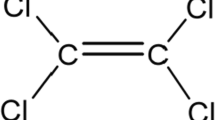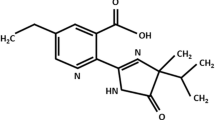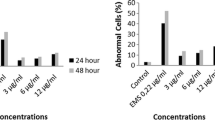Abstract
Para-Phenylenediamine (PPD), the main aromatic amines used in the hair dye formation, and its four derivatives (2-chloro-p-phenylenediamine, 4-chloro-o-phenylenediamine, 2-nitro-p-phenylenediamine, and 4-nitro-o-phenylenediamine) were examined for their potential to produce single strand DNA breaks in human lymphocytes using the alkaline comet assay. Results revealed that all the tested chemicals within the range of doses from 100 μM to 500 μM showed the genotoxicity in a dose-dependent manner after the incubation of lymphocytes with these chemicals for 2 h. In this study, we first reported that PPD and its four derivatives can elicit the type of single strand breaks in human lymphocytes.

Similar content being viewed by others
References
Bolt HM, Golka K (2007) The debate on carcinogenicity of permanent hair dyes: new insights. Crit Rev Toxicol 37:521–536
Chen SC, Chen CH, Chern CL, Hsu LS, Huang YC, Chung KT, Chye SM (2006) p-Phenylenediamine induces p53-mediated apoptosis in Mardin–Darby kidney cells. Toxicol In Vitro 20:801–807
Chung KT, Stevens Jr SE (1993) Degradation of azo dyes by environmental microorganisms and helminthes. Environ Toxicol Chem 12:2121–2132
Chung KT, Murdock CA, Stevens Jr SE, Li YS, Wei CI, Huang TS, Chou MW (1995) Mutagenicity and toxicity of p-phenylenediamine and its derivatives. Toxicol Lett 81:23–32
Chung KT, Cerniglia CE (1992) Mutagenicity of azo dyes: structure-activity relationships. Mutat Res 227:201–220
Cho JA, Oh E, Lee E, Sul D (2003) Effects of hair dyeling on DNA damage in human lymphocytes. J Occup Health 45:376–381
Fu PP (1990) Metabolism of nitro-polycyclic aromatic hydrocarbons. Drug Metab Rev 22:209–268
Garrigue JL, Ballantyne M, Kumaravel T, Lioyd M, Nohynek GJ, Kirkland D, Toutain H (2006) In vitro genotoxicity of para-phenylenediamine and its N-monoacetyl or N, N′-diacetyl metabolites. Mutat Res 608:58–71
Garner RC, Nutman CA (1977) Testing of some azo dyes and theirs reduction products for mutagenicity using Salmonella typhimurium TA 1538. Mutat Res 44:9–19
Hartmann A, Agurell E, Beevers C, Brendler-Schwaab S, Burlinson B, Clay P, Collins A, Smith A, Speit G, Thybaud V, Tice R (2003) Recommendations for conducting the in vivo alkaline Comet assay. 4th International Comet Assay Workshop. Mutegenesis 18:45–51
Horvathova E, Slamenova D, Hlincikova L, Mandal TK, Gabelova A, Collins AR (1998) The nature and origin of DNA single stranded breaks determined with comet assay. Mutat Res 409:163–171
Kadlubar FF, Fu PP, Jung H, Shaikh AU, Beland FA (1990) The metabolic N-oxidation of carcinogenic arylamines in relation to nitrogen charges density and oxidation potential. Environ Health Perspect 87:233–236
Nadin SB, Vargas-Roig LM, Ciocca DR (2001) A silver staining method for single-cell gel assay. J Histochem Cytochem 49:1183–1186
Rojas E, Lopez MC, Valverde M (1999) Single cell gel electrophoresis assay: methodology and application. J Chromatogr B Biomed Appl 722:225–254
Shahin MM (1989) The importance of analyzing structure-activity relationships in mutagenicity studies. Mutat Res 221:165–180
Sontag JM (1981) Carcinogenicity of substituted-benzenediamine (phenylenedaimine) on rats and mice. J Natl Cancer Inst 66:591–602
Visvardis EE, Tassiou AM, Piperakis SM (1997) Study of DNA damage induction and repair capacity of fresh and cryopreserved lymphocytes exposed to H2O2 and γ-irradiation with the alkaline comet assay. Mutat Res 383:71–80
Author information
Authors and Affiliations
Corresponding author
Additional information
Soi Mei Chye and You Cheng Hseu have contributed equally to this work.
Rights and permissions
About this article
Cite this article
Chye, S.M., Hseu, Y.C., Liang, SH. et al. Single Strand DNA Breaks in Human Lymphocytes Exposed to para-Phenylenediamine and its Derivatives. Bull Environ Contam Toxicol 80, 58–62 (2008). https://doi.org/10.1007/s00128-007-9316-2
Received:
Accepted:
Published:
Issue Date:
DOI: https://doi.org/10.1007/s00128-007-9316-2




